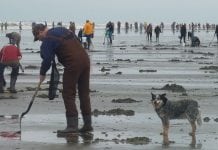By Douglas Scott
 Backpacking with children is an incredible experience. As the miles pass, children will begin to drift away from their city lives and become engrossed in nature. The wilderness is a great educational opportunity, and taking your child backpacking is opening their eyes to a classroom that has no desks or walls, just rivers, trees, mountains and animals. Backpacking is one of the few activities you can do where you are removed from the always connected home life. Camped out in the woods, your family will have the chance to bond, learn about each other and experience nature in a way that few other families do, by backpacking in the wilderness of the Pacific Northwest.
Backpacking with children is an incredible experience. As the miles pass, children will begin to drift away from their city lives and become engrossed in nature. The wilderness is a great educational opportunity, and taking your child backpacking is opening their eyes to a classroom that has no desks or walls, just rivers, trees, mountains and animals. Backpacking is one of the few activities you can do where you are removed from the always connected home life. Camped out in the woods, your family will have the chance to bond, learn about each other and experience nature in a way that few other families do, by backpacking in the wilderness of the Pacific Northwest.
We have some of the best backpacking in America right here in our backyard, but choosing a spot to enjoy with your family can be difficult. That is why I have put together a list of the best beginning backpacking trips for kids, as well as rules and tips for backpacking with your family. Backpacking trips are usually not short day hikes, so the treks we have listed may seem quite long. Remember, these are for multi-day hikes. While there are more tips and advice written on backpacking with children, following these 10 tips will help turn even the novice family into master backpackers.
Practice Hiking and Camping
 It might seem odd to practice walking in the woods, but backpacking and hiking are completely different activities. When a child hikes they typically carry little, if any, of their gear, water or snacks. While backpacking, having them carry anything will let you focus on carrying the essentials. By hiking with small packs on, both you and your child will get used to carry weight on their backs while walking on not-so-flat surfaces. For great hikes for children to get ready for backpacking, check out the Family Friendly Guidebook offered by Exotic Hikes on Amazon and as an E-book.
It might seem odd to practice walking in the woods, but backpacking and hiking are completely different activities. When a child hikes they typically carry little, if any, of their gear, water or snacks. While backpacking, having them carry anything will let you focus on carrying the essentials. By hiking with small packs on, both you and your child will get used to carry weight on their backs while walking on not-so-flat surfaces. For great hikes for children to get ready for backpacking, check out the Family Friendly Guidebook offered by Exotic Hikes on Amazon and as an E-book.
To help get used to sleeping in a tent, take three or four days leading up to your trip to sleep in the tent. Preferably, do this in all sorts of weather to reassure both you and your child’s belief of the weather- proofing of your tent.
Plan an Itinerary
Every backpacking trip with children needs to be planned and over planned. Checking out maps, seeing if there are creek crossings and locating backcountry campsites with bathrooms are all needed activities, most of which can be found via the Olympic National Park website, specifically the backcountry map section. First time backpacking for children should be no more than a few miles a day, unless you know they are ready and capable to do more.
Once you have the needed resources, let your kids help plan. Including them will give them a sense of ownership of the trip, even if it is just for finding places to have snacks. This is also a great educational opportunity to teach them map-reading and reinforce simple math skills.
Once you have made a realistic and detailed itinerary, make sure you leave a copy with a loved one, a neighbor and anyone else you can trust to contact the proper authorities if you don’t return home when you are scheduled to do so.
Permits
 The red-tape of backpacking can be quite frustrating, depending on where you plan to camp. Some locations require prior approval to certain sites, while other locations are first come-first serve with a simple permit you attach to your bag. Either way, the best people to contact to find out what permits you need are at the National Park Service Wilderness Information Center and the National Forest Service Office.
The red-tape of backpacking can be quite frustrating, depending on where you plan to camp. Some locations require prior approval to certain sites, while other locations are first come-first serve with a simple permit you attach to your bag. Either way, the best people to contact to find out what permits you need are at the National Park Service Wilderness Information Center and the National Forest Service Office.
Enthusiasm is Contagious
Your first family backpacking trip is sure to have some stressful moments, but the way you respond to adversity will make or break your child’s experience. Your mood and the way you carry yourself will directly impact how your child reacts to the tiredness and strangeness of being away from home for an extended amount of time. If you and the rest of your family appear to be having a great time, your children will eventually start to take joy in the same activities. Kids are a lot more resilient than we give them credit for, so the more upbeat you are about the experience, the more they will think they should be happy too.
Check the weather
Not much else can ruin a backpacking trip like terrible weather. Avoiding rain altogether in the Pacific Northwest is nearly impossible, but the heavy rains and strong winds can be avoided with a simple check of the weather. When checking the weather, it is important to remember that predicting the weather in more remote areas is hit and miss. Your best bet for accurate weather forecast is from the National Oceanic and Atmospheric Administration, better known as NOAA. The site takes a bit of time to get used to, but spending an hour exploring how to work it will save a few miserable days and a lifetime of bad weather memories.
Know your terrain
 Knowing your terrain is incredibly important, as being able to prepare for upcoming hills or creek crossings can make backpacking with your child much easier. Going to http://caltopo.com/ , finding the right topographical map and printing it out not only lets you have the map with you at all times, but also can be a great learning tool for your child while hiking. A pro-tip is to keep the map in a ziplock or clear sealable bag at all times; that way you can still use it while it is raining.
Knowing your terrain is incredibly important, as being able to prepare for upcoming hills or creek crossings can make backpacking with your child much easier. Going to http://caltopo.com/ , finding the right topographical map and printing it out not only lets you have the map with you at all times, but also can be a great learning tool for your child while hiking. A pro-tip is to keep the map in a ziplock or clear sealable bag at all times; that way you can still use it while it is raining.
What should you bring?
Packing for a backpacking trip is one of the harder things to figure out. Not only do you need a good, comfortable and waterproof backpack, but you also need food, cooking gear, sleeping bags, a tent and clothes. All of this gear will need to fit into a backpack or two, with your child realistically able to carry very little. Depending on the age of your child, it isn’t too much to ask them to carry their sleeping bag and maybe a little food. More than that and they may not be able to handle it, physically and mentally. The rule of thumb is to carry about 20% of your body weight. REI does a good job giving advice on how to pack your pack properly in this article.
Aside from the obvious essentials, it is important to bring a few other things to ensure a good trip. A water purifier is a must, as staying properly hydrated is important for your mental and physical health. Sure, you might be bringing a stove and will boil water to drink, but being able to drink cold water right away has true value. Bringing iodine tablets and something to flavor water is also an excellent way to quickly purify water. Besides a water purifier, bringing a wide variety of foods will help make meals more exciting and reenergize both you and your child. Nothing is worse than hiking all day and finding that none of the food you brought sounds appetizing. Bringing salt and pepper or tabasco can help a meal taste better as well. Mountain House makes a wide variety of freeze dried foods that are light, easy to make and for the most part delicious. Make sure you bring snacks like gummy bears, jolly ranchers, dried pineapple, jerky and trail mix, as eating will boost energy and moods as much as water.
Footwear
 Having good shoes and comfy socks is important for every aspect of backpacking. You will be on your feet most of the day, carrying more weight than you are used to over terrain that is not flat or level. That is why having good shoes for you and your child is extremely important. Hiking boots or shoes should be worn quite a few times before going on a backpacking trip, as most pairs need to be broken in.
Having good shoes and comfy socks is important for every aspect of backpacking. You will be on your feet most of the day, carrying more weight than you are used to over terrain that is not flat or level. That is why having good shoes for you and your child is extremely important. Hiking boots or shoes should be worn quite a few times before going on a backpacking trip, as most pairs need to be broken in.
Entertainment
Inevitably, there will be a time between dinner and bedtime when you will need to occupy your time in the woods. Normally, you could take a walk around camp and explore, but after a day of backpacking, sitting around camp might be more appealing. If you do just want to sit around camp, make a fire, play cards or tell stories about your childhood. Your kids might not seem interested, but it was at moments like this that the world’s history was passed down to future generations. This is special time for you and your family, free from distractions and perfect for that illusive family bonding time.
Safety
Safety while backpacking is important, which is why bringing a first aid kit and knowing how to use it is required. If you do already have a first aid kid, double check to make sure all the supplies you need are in it. Backpacker Magazine put together a great and simple list of what you should have for emergencies. Remember that cell phones will more than likely not work, so communication with the outside world is limited. That is why leaving a detailed itinerary with family, as well as sticking to the itinerary you gave to the rangers will be incredibly important if an accident were to occur.
Best Beginner Backpacking Trips in Olympic National Park Near Grays Harbor
Hoh River to Olympus Guard Station
Directions to trailhead: http://goo.gl/maps/LCBPN
Distance: 19.4 Miles Round Trip
Camp Sites: Every 2 to 3 miles
Best Camp Area: Five Mile Island
What Makes it Great: Hiking along the Hoh River Trail, witness old growth forests, neck high ferns and moss growing on everything in sight. With elk herds regularly seen, as well as the occasional eagle or osprey fishing in the deep blue water, taking a multi-day trip along this mostly flat trail is perfect for those looking to experience wilderness camping in one of the best temperate rainforests in the world. The trail is easy to follow, the campsites are well-maintained and the experience is world class. This is the perfect starter trail for backpackers of all ages. Hike to the ranger station, or just hike 5 miles or less to have a beautiful riverfront campsite.
More information: http://www.nps.gov/olym/planyourvisit/hoh-river-trail.htm
Hole-in-the-Wall to Norwegian Memorial
Directions to Trailhead: http://goo.gl/maps/HGYCO
Distance: 7.6 Miles Round Trip
Camp Sites: Every 3 to 4 miles
Best Camp Area: Any
What Makes it Great: A walk on the windy, rugged Washington Coast may not sound fun to some, but backpacking along the beautiful and remote Olympic Coast is one of the more memorable, easy backpacking trips you can take. Sure, you might get sand in just about everything you bring with you, but seeing otters, seals, eagles and possibly whales is sure to bring a smile to anyone’s face. With gorgeous sunsets and endless tide pools to explore, camping at Hole-in-the-Wall creates a lifetime of memories in a short few nights. Be aware of the weather and tides on this hike, as it can get pretty rough during wet and windy days.
More Information: http://www.protrails.com/trail/585/olympic-national-park-chilean-memorial
Staircase to Home Sweet Home
Directions to Trailhead: http://goo.gl/maps/00fWk
Distance: Up to 24 Miles Round Trip
Camp Sites: Every 2 to 4 miles
Best Camp Area: Nine Stream
What Makes it Great: Staircase is commonly done by youth groups and Scout troops, but don’t let the popularity fool you into thinking this is an easy trek. Skirting the Skokomish River the entire way, this well-maintained trail is perfect for those looking to get a little more from backpacking. With campsite every few miles, taking your time to get to Home Sweet Home Camp, which sits near First Divide is an incredible experience. Even if you don’t make it to Home Sweet Home camp, the tower fir and cedar trees along the route will impress everyone. Highlights also include bridge crossings over creeks and the Skokomish River.
Quinault’s Graves Creek to Enchanted Valley
Directions to Trailhead: http://goo.gl/maps/g5oL5
Distance: 27 Miles Round Trip
Camp Sites: Every 3 to 4 miles
Best Camp Area: Enchanted Valley
What Makes it Great: This backpacking trip is the quintessential backpacking experience of Olympic National Park. Following the always gorgeous Quinault River, head through old growth timber, across beautiful cascading creeks and even cross a deep box canyon on a wooden bridge on your way to a waterfall-flanked valley. While the main draw of this hike tends to be the Enchanted Valley Chalet (now sitting precariously on the banks of the Quinault River), the entire region is known for elk, bear and waterfalls tumbling down the rugged cliffs on the opposite side of camp and the river. Sitting here is truly a magical family backpacking experience that everyone should have.












































